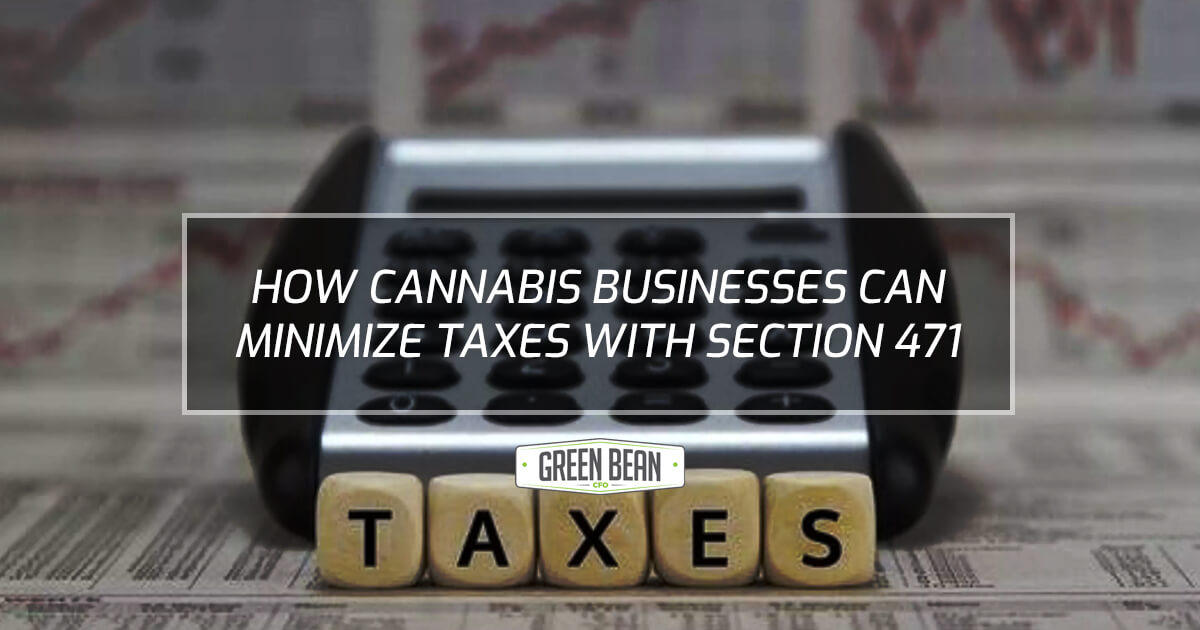How Cannabis Businesses can MINIMIZE TAXES with Section 471

What the Hell is §471?
Internal Revenue Code §471 is the section of tax law that deals with rules for inventories. It also spawned the regulations that you must apply to your cannabis inventory to be in compliance with the IRS and to maximize your tax write-offs. Many state cannabis laws specifically require GAAP cost accounting as well, which also requires adherence to these tax regulations.
To minimize the amount of income subject to federal tax under the punitive tax law, §280E, you must correctly calculate your Cost of Goods Sold (COGS). COGS is not subject to income tax, but you must consistently and properly allocate costs per regulations §1.471-11(or -3) to cannabis products which are specifically identified in periodic inventory procedures. Upon sale of these marijuana products, you are allowed your COGS tax deduction.
By issuing financial statements in accordance with GAAP (Generally Accepted Accounting Principles), additional expenses may be allocated under regulation §1.471-11(c)(2)(iii) to maximize COGS, resulting in the absolute minimum in taxes levied under IRC §280E. As mentioned, it gets even more difficult for cannabis manufacturers (generally cultivators) with greater than $25 Million in revenues (as of 2018), who must also apply the UNICAP rules under §263A, but should be doing it anyway to maximize deductions.
How Do You Apply This?
Let’s look at a cannabis grow operation:
Seed or clone to product may take 120-180 days. Stages and activities include veg, growing, watering, harvesting, watering, drying, curing, testing at the lab, then labeling the cannabis products and transporting them to the dispensary. How much does it cost to grow a pound of pot? You start with a seed or a clone which is minimal and is considered “Raw Material”. In a cannabis company, your raw materials at the end of a reporting period are usually very low. You probably won’t have many “Finished Goods” either, because you immediately take your finished product to the dispensary and sell it. This leaves a clear majority of your inventory in the “Work in Progress” (WIP) stage, and the way you value WIP is with a flower calendar. You may have thousands of plants consisting of various strains; for each strain, you need to know how far along it is. You conduct inventory and assign a percentage complete depending upon how far along you are on your flower calendar. For example: your flower is trimmed and dried and you are picking samples up from lab tomorrow – it is 99% complete. For each strain, you will need to estimate the yield per strain from your “Operations Farmers Guide” and keep track of how many of each plant you have and how close to complete they are. From there you perform cost accounting and start allocating direct and indirect costs (see below) to your crop – items such as direct labor, indirect labor, utilities, security, nutrients, supplies, soil, testing, etc., Keep in mind that if the IRS determines that you are doing this correctly and in accordance with GAAP (Generally Accepted Accounting Principles), you can allocate even more costs; scrap, rework, depreciation, etc., to Cost of Goods Sold (COGS) and minimize the taxes you pay. Unfortunately, most cannabis businesses are doing this wrong. Do it right, and you have a competitive advantage.
Why do all of This?
If your Tax provider did not let you know this, and your recurring financial accounting (not year-end tax accounting) is not cost accounting i.a.w. GAAP, there are only two possibilities, and neither are good:
- Your tax return is incorrect
- You are paying too much in taxes
Simply stated, you need to do proper cannabis accounting for several reasons, all of which improve your cash flow: to provide transparency to better manage your business, to be prepared for any capital raise (lending or equity), and to reduce your tax bill. The cannabis industry is rife with bookkeepers who simply don’t have the knowledge or training to perform GAAP/ cost accounting and it’s also filled with tax preparers who don’t properly follow the 280E/471 guidelines, putting the CEO at risk of penalties, fines, lower margins, and lower profitability.
Using a conservative estimate of these costs being at 10% of revenue, proper cannabis accounting will result in an extra 2-4% of revenue in your pocket, and lower risk of heart attack from audit induced stress.
What Might You be Able to Deduct?
Costs of Goods Sold with proper accrual/ cost accounting include:
Direct Costs
- The cannabis crop: Seeds, plants, clones, pesticides, nutrients, water, grow/ cleaning supplies, fertilizer, packaging, printing & design, testing and lab fees, pH testers, paraphernalia, etc.,
- Retail items: Invoice price of Cannabis purchased, less trade or other discounts and transportation or other necessary charges incurred in acquiring inventory of cannabis for resale
- Labor directly involved with purchasing, handling, planting, cultivating, harvesting, trimming, etc.,
o Associated workers’ comp, payroll taxes, holiday & vacation pay, OT, and fringe benefits such as life, health & dental insurance
- Subcontractors and temporary labor related to production with or without a 1099 issued
- Some management company costs for dispensaries and cultivation operations
Indirect Costs
- Utilities such as water and electricity/ fuel & security systems – all used in the cultivation facility
- Rent for cultivation facility, storage/warehousing space (possibly a portion of the dispensary)
- Indirect labor, such as for Security guards or cleaning the cultivation facility, etc.,
- Repairs, maintenance, cleaning supplies as well as some tools and equipment/ rental equipment
- Quality Control and inspection costs, sampling & R&D
- Licensing of cultivation facilities, vehicles, legal and professional services for cultivation facilities
Additional Costs of Goods Sold when included in GAAP Financial Statements
- State/ local/ foreign real and personal property taxes & general sales tax up to aggregate $10k
- Crop damage/ forced destruction of a crop, costs attributed to strikes, rework, scrap & spoilage
- Depreciation reported in financials for equipment used in manufacturing, extracting, etc.,
- Employee benefits to extent related to labor above (401(k) plans, profit sharing, workers’ comp, stock bonus plans, life & health ins prem, cafeteria plans, gym memberships, medical treatments, recreational facilities and gym membership dues, etc.,
- Performing inventory and administrative functions related to manufacturing (NOT cost accounting)
- Officers’ salaries that can be traced to the production, extraction, or manufacturing of cannabis or its extracted material
- Most of the insurance costs that are attributable to the production, extraction (both for the facility and the equipment in the facility) of cannabis
Author: Brian S. Whalen, CPA/ MST




